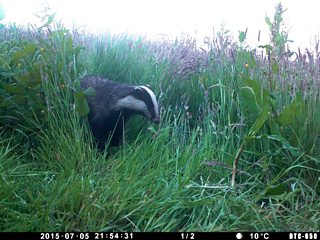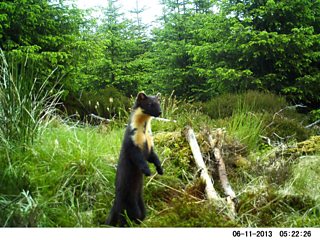Camera traps鈥he door to a secret world!
The Mammal Society
Partner organisation of the Watches
By Rose Toney, Training and Events Officer at the Mammal Society
Until a few short years ago, camera traps were the preserve of the hunting fraternity and the scientific community, where they were employed to monitor elusive, often endangered species in some remote part of the world. They remain a vital tool for ecological research and conservation, but, with the increase in technology and decrease in price, camera traps (or trail cameras, as they are also known) are providing a window on wildlife in our communities, schools and indeed our gardens.

A badger emerges from the vegetation, captured as part of The Mammal Society's camera trap project
I was first bitten by the camera trap bug almost a decade ago, having borrowed one from a colleague. The excitement I felt when checking the memory card for the very first time and seeing a pine marten has never diminished; ten years on, I still get that rush of anticipation and excitement when I check the cameras. There have been some great discoveries along the way, including footage of a young goshawk exhibiting play behaviour with pine cones. And several years of experimentation have led to the development of the “small mammal cam”, which has revolutionised the recording of small mammals for both work and play.

An elusive pine marten is snapped by a camera trap. Photo from The Mammal Society
Over the years I’ve been privileged to work with a huge range of groups, of all ages and backgrounds, including over 50 schools, helping them discover the joys of camera trapping. It is difficult for communities to value or protect that which they are not aware of. Many animals are elusive or nocturnal and local residents often have no idea of the species that they share their space with. Camera traps are a fantastic way to help people discover, and value, that secret world.

Camera trapping has become more and more accessible - why not find out what's in your woods? Photo from The Mammal Society
Not everyone will have a pine marten on their camera trap, of course, but there is great joy to be had in watching the often-surprising range of animals that lives alongside us. We can thrill at their behaviours and interactions, and delight in the arrival of young as the seasons progress. And this information can prove invaluable to research and conservation. With their ability to gather images remotely, record large amounts of data and provide a method to verify records, all at relatively low-cost, camera traps are becoming an increasingly popular citizen science tool. The Mammal Society has been working on a number of projects involving the use of this technology. With cameras available to buy, and very often to borrow, we hope you will take part in our next camera trap project. and on social media!
